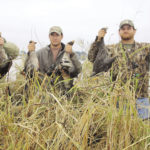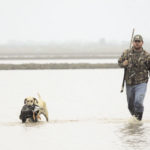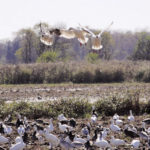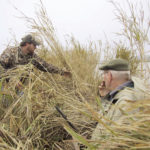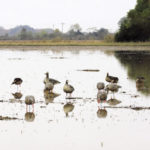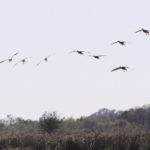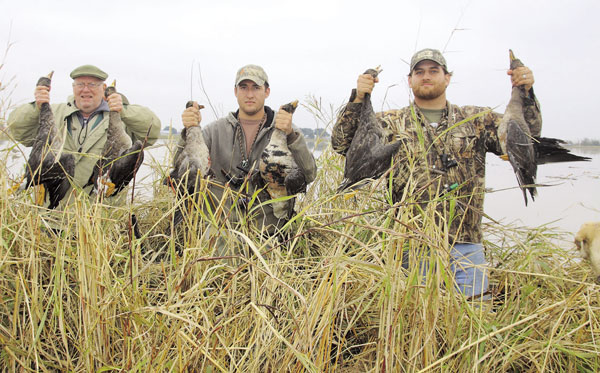
Put what these guides have learned to work on wary late-season geese.
Soft yelps and yodels from a specklebelly slipped across the atmosphere overhead, where a high winter fog hid circling birds from our view. By contrast, a slight northerly breeze kept much of the wet mist off the face of the flooded rice fields where we set up along a levee. A flock of 500 — give or take — mixed snows, blues and specks nervously milled about one field over from ours.
It’s one thing to create a ruse that looks natural to wary specks. It’s another to compete with the real thing close by.
Looking up, we watched their shadowy silhouettes appear then disappear in the misty precipitation, clearly breaking all visual flight rules for the weather conditions. These were educated geese that knew better than to just drop into the full-bodied decoys below. Moreover, we didn’t feel bad — they even gave their brethren in the next field the once over as an extra precaution before starting their descent to join them.
The trump cards in this equation happened to be Matt Fontenot and Ian Woods, two young guides who grew up in rice-field country getting an education of sorts too at Doug’s Hunting Lodge in Klondike.
In spite of the morning’s brief challenges, both guides confidently broke the silence coming from our field with a few yelps and yodels of their own.
Who said America’s young people aren’t multilingual? All one has to do is come to this part of the state where Vermilion, Cameron and Jefferson Davis parishes come together to prove otherwise.
It was clear to me that these two 22-year-olds had somehow learned to speak both specklebelly and mallard proficiently. And quite frankly, they apparently had the dialect correct, too, because the specklebellies dropped from high above, beginning a wide arc that would take them past our hideout buried in the rice field levee.
Woods, a champion speck caller, worked a series of savvy yodels, while Fontenot seemed to play what old rockers would call rhythm guitar — blending licks of clucks, yelps and staggered yodels complementing his partner.
I simply watched anxiously and slack-jawed, when after several passes and nearly six minutes of calling, two of the specks made their final approach. With orange landing gear extended, the birds were now committed to our decoys upwind located just northeast of the blind. With the birds no more than 30 yards above us, Fontenot yelled, “TAKE ’EM!”
It’s during the latter part of the second-split of Louisiana’s waterfowl season when the homework and study the two young guides put in, like others before them, has paid off for Doug Sonnier’s customers.
Fontenot works as an Instrumentation Technician for Water Draws, LLC, when not guiding.
“Before the season opened, I came out here, and sat with my calls working ducks and specks, just to see what they liked and how they’d react,” he said.
Woods, a senior at McNeese State University majoring in agricultural science, who has known Fontenot since elementary school, agreed with his friend.
“You’ve got to know how to do that as a guide — how to stay concealed and just watch them sometimes,” he said. “You want to see if they respond to fast or slow, loud or kind of muffled, if they like clucking or don’t like it, or if they like single or triple notes.”
Sonnier pointed out the obvious of having to know how to call to be an effective hunter.
“There’s got to be a desire,” Sonnier said. “If they have the desire, they can learn to call. And over the years they teach each other. It used to be, they’d all be in the parking lot of the lodge and everybody would be calling — and somebody would be out there in the middle of them teaching them. But, they all had the desire, all of these boys who guide for me; that’s what they wanted to do.”
An hour or so into our hunt, the breeze died down and the gray sky began to turn blue. The specks began to flare. Immediately, Fontenot shut down the hunt for a few minutes to re-brush and attempt to restore a more natural look to our hide.
“You’ve got to think about it,” he said. “What’s the bird seeing when it’s coming right over you? It might look good on our level, but geese in general are a lot smarter than people think. Any hole in the blind, any part of your face, anything that they can see that’s not normal to the levee — that’s it. They’re on to you.”
Where the levee we were stationed was grass covered, the levees of the surrounding fields were mud the full length.
“If we were hunting that levee, we couldn’t use the grass we’re tucked in,” said Fontenot, pointing at the mud levee across from us. “That would be totally different. You want to keep, as best possible, the same consistency down your levee. In other words, you want your whole levee looking exactly the same.”
The later in the season it gets, those anomalies along rice field levees, where grass has been smashed in sections by hunters, are avoided by birds that have wised up from hunting pressure. The quick action by our guides, responding to the way the birds flared, made a good hunt even better.
The grass cover they added became a game changer, proving not only had the young men paid attention to their calling lessons, but also the mentorship from the older guides they hunted with.
“When I started coming here at 10, 11 and 12, hunting with all these different guides, everybody had their own different techniques,” Fontenot said. “What played a factor with me was you could take all of that knowledge and stick it together. Everyone had a different style, everyone had a different trick.”
One trick that Fontenot utilized late in the 2009-10 season was to take the geese they harvested and prop them up with sticks. Each time a goose was harvested, the young guide would add it to his all-natural spread.
“We started out with regular decoys,” he said. “Tt was late-late in the season, and the geese were actually flaring. They were decoy-shy, and they were used to seeing them. So, what we did was take those decoys out, and use no decoys. They were actually coming to just the sound of the call in range to shoot. As we’d knock down one or two, we folded their wings in and propped up their heads. I mean, what’s more real looking than a dead goose? We had a little breeze and those feathers moved — well, it looks a whole lot better than a plastic decoy.”
The longer the season progresses, the guides pointed out the fidelity that geese have to the region they hunt. However, that fidelity only goes so far, as wiser geese begin to avoid areas where they’ve been shot at from blinds below.
“That’s why we as guides, who are hunting everyday, if we’ve got a flock of 20 specks, try to avoid shooting at a flock like that, unless we know we are capable of taking our limit,” Woods said. “If you see five coming, followed by another two that you know you’re going to kill, take the advantage and kill the two. We don’t want to spook them out of the area, or prevent them from coming back. With speck hunting, you want to avoid shooting as much as possible. That’s what’s going to be your biggest key, so you’ll have productive hunts over and over again throughout the season.”
Quite often, what hunters who engage full-service outfitters like Doug’s Hunting Lodge don’t realize is the time guides put into scouting beforehand. Fontenot, who is an avid deer hunter, says there is perhaps more scouting required to successfully hunting geese than deer. Comparing the range deer typically travel to that of a goose, Fontenot’s theory is a deer lives in roughly one square mile, where a goose’s range is unlimited.
Fontenot insists that in order to be a successful goose hunter you have to know where the birds are at all times. Once big bodies of geese are located and depending on whether you have access to the field, the two guides suggest setting upwind from them. If you locate two large bodies, hunters should attempt to get in between them. But, basically, the idea with scouting is, you just can’t go and sit anywhere and expect to shoot geese.
Other tactics the two guides employ from time to time, when geese tend to be particularly wary, is to simply move away from the blind and get more into their flight path. Problems with spooky, unresponsive geese do and will occur late in the season. Subtle adjustments in blind location can pay dividends when hunters are struggling to get closer shots.
Another tactic Woods referred to as an old guide’s trick is to take your four-wheeler and muddy-up the water between decoys to create a more natural look within the decoy spread.
Outside of the numerous details guides like Fontenot and Woods excel at in order to ensure client success, there are also people skills they must master.
Fontenot told the story of how two doctors from India came to hunt at the lodge, having never hunted before. The young guide even had to show them how to load their guns. But, at the end of the day, the inexperienced hunters had shot three boxes of shells and had a whole lot of fun.
It didn’t take long for us to take three limits of specks, plus several ducks. What the two guides gave up in age proved to be more than made up through their hard studies in the outdoor classrooms they attended at Doug’s Hunting Lodge.
